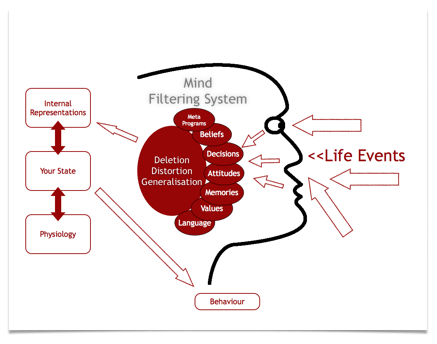Have you ever wondered what makes you behave the way that you behave? What is it that generates good and bad feelings inside of you? What happens inside you so that one day you wake up and everything in the world seems fantastic and then the next day everything seems really depressing and negative?
Want to find out? This can all be explained by something that is known as the NLP Communication Model.
Take a look at the picture above. Let’s say that this person is walking down the street, they are just walking along taking in the scenery. They are taking in the scenery by seeing things that are going on in the street, say cars parked by the side of the road. They are hearing things, like birds singing, touching things, for example the pavement under their feet and the air temperature on their skin. They will also be smelling various smells, and they will also be tasting things, like the fresh air.
Now they may not be doing all of these things consciously but their brain is registering it all for them anyway, and if they choose to pay attention to any or all of these inputs then they are able to do that. Just stop reading for a minute now and just notice your environment, notice what you can see, hear, feel, smell and taste.
I’ll bet that you hadn’t noticed half of that before you stopped and did it consciously did you?
Anyway, this information is taken in by our imaginary NLP person through their eyes, nose, mouth, ears and through touch on various parts of the body. The information is collected in this person’s brain and it is placed through a filtering system. The information is filtered based on, amongst other things, that person’s beliefs, decisions, attitudes, memories and values.
This filtering is basically taking the information that is being received and automatically reshaping it, interpreting it based on past experiences. So, for example our NLP man sees a blue car, blue is his favourite colour based on a decision that he made in the past and so the fact that he sees the car, his brain registers that it is blue and matches blue to being his favourite colour, this then registers as a picture and a feeling consciously with our NLP person. The brain took the information, filtered it and represented it to them. This leaves our person with a what we call an internal representation and a memory of that instant.
As the car was blue this internal representation was probably a good one for this person and their internal representation may have resulted in them feeling happy, or at least slightly happier, this has altered their state slightly.
Since they are now marginally happier than they were NLP person may have a spring in their step, they may walk a bit faster and they may be smiling to themselves. If this happens then seeing the car has changed their physiology.
So seeing the car produced an internal representation which was favourable since it was in their favourite colour (a past decision – a filter), this changed their state to one of increased happiness, and this produced a spring in his step. If they really liked the look of the car, then they may walk over to have a closer look at it and if this happens then seeing the car has also resulted in some behaviour, altering their path to take a closer look.
If when they go over to the car the alarm goes off (another life event going in through the senses) this could register a warning with the brain based on a belief that they may get the blame for setting the alarm off, this will produce an internal representation, a state of panic maybe, and they may well run off quickly down the street feeling a bit hassled and breathless looking over their shoulder to see if anyone spotted them.
In this case the belief that they may get the blame resulted in the event being filtered into a negative internal representation, resulting in a negative state and evasive behaviour. If NLP persons belief had been that car alarms go off all the time and the owner of the car will just stick their head around the curtain and turn it off with their key fob, then their behaviour may well have been considerably different and their resulting state and feelings may have been much better.
We can see from this example how our beliefs, values, decisions, memories and attitudes, all of which were generated at some stage in the past, affect the way that we feel and the way that we behave. Since these things are accessed automatically by our brain it is always a good idea to make sure that the beliefs and values etc that you have support you now in the way that you want to live your life.
If you are generating behaviour in your life that you are not happy with, then it is because your filters are out of date with how you want to live your life right now, change your filters and change your behaviour.
This concept and a whole library of other topics are covered in depth in our NLP Training Courses and you can study NLP online at our NLP e-Learning portal.

